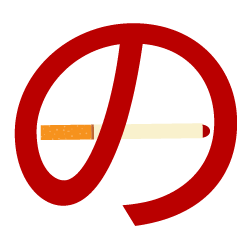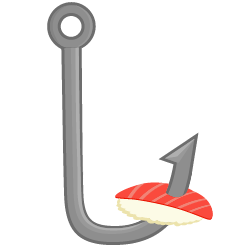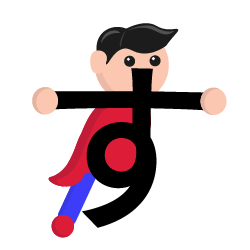
Looking back, I could have learnt Japanese instead of Chinese. After all, I practised Judo and Jujutsu for many years, I watched at least a hundred hours of anime (favourites are Ghost in the Shell and Spirited Away), and l was interested in Zen Buddhism for some time. I thought Japan seemed like a fascinating place.
But I never learnt the language.
I can honestly say that a week ago, I knew less than a dozen words and no grammar or set phrases, except konnichiwa. The only kana I knew was の because it’s occasionally used in Taiwan to mean 的.
Instead of learning Japanese, I’ve spent the past twelve years first learning and then teaching and writing about Chinese, which is my limited claim to fame (if you know me at all, it’s probably because of Hacking Chinese).
So, my starting point for Japanese is that I know some 5000 Chinese characters, but almost nothing about the Japanese language.
An experiment in learning Japanese
This article is the beginning of an experiment where I will learn Japanese and share my experience with you. The idea popped up while trying out the beta version of Skritter: Write Japanese, and rediscovered the joy of learning a language from scratch.
This is not going to be a no holds barred frontal assault on learning Japanese; I’m way too busy with work and life. Instead, it will be a measured, leisurely and curiosity-driven attempt to learn some basic Japanese using modern technology, online resources and the guidance of someone who has learnt Japanese successfully from home: Jeremy, Skritter’s Japanese guru.
The format for this project is quite simple:
1. Set a medium term goal (an area of Japanese to explore, some learning goal to accomplish)
2. Study when opportunities arise (on trains, in supermarket queues, in bed before falling asleep)
3. Reflect on my learning, evaluate it with Jeremy sensei and then write an article about it
4. Set a new goal; repeat
These blog posts will detail what I do, my own reflections on my learning based on my general knowledge and experience of language acquisition, along with Japanese expert comments and suggestions from Jeremy. I also invite comments, suggestions and questions from other learners, especially those Skritter users who are also learning Japanese.
Enough talking, let’s learn Hiragana!
Olle learns Japanese, part 1: Hiragana
My first goal was to learn Hiragana. This is part of the guest experience in Skritter: Write Japanese. There is one deck that introduces all the kana, how to write them, how they are pronounced and so on. There are also some words and a handful of short phrases. Check out the list here.
Here’s what I did:
1. Went through all Hiragana in learning mode (two hours spread out over a week) – Learning mode consists of studying the character, tracing it, writing it with guide and the writing it without guide. Follow-up testing and reviewing is necessary to commit the kana to long-term memory. The time given includes learning, testing and reviewing, plus minor look-ups on Wikipedia (see below).
2. Transcribed ten sections of かぐや姫 or Princess Kaguya, (one hour in total) – I copied the hiragana from these stories into a text document, then wrote the romaji below the text, then pasted the correct hiragana below my own transcription and checked for errors.
To verify that I know hiragana, I think I should also try transcribing stories in the other direction, i.e. going from romaji to hiragana. I should also learn how to type kana since I have no great interest in copying the characters from a dictionary or writing by hand. I assume these steps are quite simple, though.
Learning meaningless things is hard
An oft-repeated axiom of language learning is that learning should be meaningful. Things that make sense are easier both to understand and to remember. However, the main function of phonetic symbols is to represent sounds, so they often lack meaning. The letters “l” and “b” don’t really mean anything; they just represent sounds in the spoken language.
Learning what are essentially arbitrary squiggles (at least from the learner’s point of view) is very hard. The Hiragana deck in Skritter includes mnemonics in the form of pictures that are clearly related to the sound of kana, and at least somewhat related to the written form.

の

し
Some of these were great and made the written symbols stick almost immediately, others just didn’t work for me. There is some evidence in the literature that mnemonics are quite personal and that creating them on your own is beneficial. My approach was to use the mnemonic in Skritter, and in the few cases where that didn’t suit me, make up my own.

す

ゆ
In some cases, I created my own mnemonic even if the one in Skritter was good. For example, the mnemonic for ゆ is “musical instrument”. However, in my mind, the kana is almost identical to the way I would draw a simple fish. Since yu2 in Mandarin means fish, this was super easy to remember; I basically saw it once and never forgot it.
While superman has nothing to do with the kana す, it lends meaning to the written symbol, making it much easier to remember. Memorising random squiggles is hard, so try to avoid it if you can.
Noticing patterns in the arbitrary squiggles
Another thing I found very helpful was noticing patterns in Hiragana. Some things seemed systematic, so I looked them up briefly on Wikipedia to confirm. Knowing that the “ mark means a voiced version of the same sound basically gave me a bunch of kana for free. Similarly, knowing that the circle thing changes h to p also gave me some free kana. It seemed to me there should be some rule or other for…
ぬ
め
ね
わ
れ
…but I can’t see any pattern there nor is one mentioned in the Wikipedia article.
More ways than one to transcribe a sound
I thought learning has gone smoothly so far, but one thing kept trolling me for a bit before I realised what was going on. It seems that some sounds can be written in more than one way. For example, ji can be both じ and ぢ, and zu can be both ず and づ. This is obvious when you look at a table of hiragana, but it’s not obvious when you learn them one by one and review them in a somewhat randomised order. I thought I got them wrong numerous times before I figured out that there were actually two correct answers. Tricky!
Wrapping up, moving forward
I have now spent roughly three hours learning Japanese and I think I know hiragana reasonably well, as in I can recognise and transcribe them all to romaji and can also write them by hand if prompted given romaji.
However, I don’t understand anything in the stories I have transcribed. I think the next step should probably involve learning some words. What do you think, Jeremy sensei?
Expert opinion
You’re definitely on the right path and the progress you’ve made in a short amount of time (3 hours) is very good. After you’ve learned to recognize kana, I recommend being able to write them (as you already have!). You did mention having not much interest in handwriting since you would only be typing, however you’ve written an article about this yourself: “Why writing helps you remember better than reading“.
With that said, if someone isn’t interested in handwriting, while they shouldn’t skip learning to write kana from memory, kanji could be focused on recognition only and not handwriting, though it’s still immensely helpful to learn to write kanji from memory.
In your case since you’re already familiar with 5,000+ Chinese characters and a lot cross over into Japanese, this is for the most part covered. You’ll run into some 国字 (こくじ), or characters that were created in Japan– you of course won’t know these already, however there’s not too many. As a side note, in some cases Kanji may take on a simplified form versus traditional, like 学 in Japanese for instance, where in traditional Chinese it’s 學. (Most of the time Japanese uses a traditional form, so you might think it would be written as 學 in Japanese if you’re familiar with the traditional Chinese character, and are familiar with how Japanese mostly uses traditional type forms).
Transcribing stories that are in written in Romaji into Hiragana on a keyboard is somewhat pointless since you can (for the most part) type what you see in Romaji, and it will automatically convert to kana on the keyboard. Doing this with handwriting however is a good idea and reminds me of a type of practice where you see nothing but kana text, and rewrite it using Kanji/Kana. (This is called 書き取り or かきとり).
Doing this from Romaji into Kana however, there are a few cases (that you’ve already noticed while studying!) where this doesn’t always work. Often ず and づ are both listed as “zu” in romaji, and ち and ぢ are both listed as “chi”. To type these on the keyboard however, you need to enter “zu” for ず and “du” for づ. For ち, you would type “chi”, and for ぢ you would type “di”. These are also sometimes listed as “dzu” and “dzi” as well, which lines up more closely to how they’re pronounced while differentiating them in romaji from “zu” and “chi”, however most Japanese IMEs require you to type “du” and “di”. In other words, the way to type on a keyboard doesn’t always line up with how Romaji is being presented in other places.
While on the topic of Romaji, there are different systems in use (two main ones mostly). The two main systems used are 訓令式 (くんれいしき), or Kunreishiki , which is used in Japan, and Hepburn which is used in the west. As an example, よろしく in Kunreishiki is written “yorosiku”, and in Hepburn Romaji it’s “yoroshiku”. The character ふ is written as “fu” in Hepburn, but “hu” in Kunreishiki. Another example for instance is putting a line above an “o” to indicate it’s a long sound (おう versus お)– so using a word I’ll explain later, “Manyougana” is in one style, and another would be Manyōgana. In general, Kunreishiki is considered to be a “superior” form of Romaji, however it’s just not used in the west and isn’t what you’ll likely see in textbooks.
The best part of Romaji is that once you’ve learned kana, you can (and should) immediately throw it out. It’s a necessary crutch to learn kana and how it’s pronounced, but kana should only be used moving forward once you’ve learned both Hiragana and Katakana. It’s inevitable on the keyboard however unless you’re using direct Japanese input, which not even a lot of people in Japan use, and they type in Romaji and convert to Kanji/Kana. (Plus you’d have to completely learn a new keyboard mapping if using direct Japanese input).
You mentioned kana are essentially arbitrary squiggles. This is an accurate statement from a learner’s point of view and is a lot like learning English letters which don’t carry a meaning on their own, like you mentioned. Since Kanji are built on concepts, it’s easy to remember that 休 means “rest”, and mnemonics are helpful– a person leaning against a tree. However remembering that あ is pronounced “Ah” (or “a” in Romaji) doesn’t have a real logical method (on the surface!) to why the shape corresponds to the sound. Hopefully the mnemonic images help bypass this!
Kana aren’t actually arbitrary squiggles, however! Kana were created based on Kanji and their shape and sound, like a super-simplified form of Kanji, but used to phonetically transcribe Japanese.
Kanji is in black on top, Manyougana (in a cursive style and used before kana was created) in red in the middle, and the final transformation into the Hiragana you recognize today at the bottom.
The sounds Hiragana use correspond to which Chinese character they came from, and how they are pronounced in Japanese. As you can see in the chart above, it also determined their shape. To cherry pick a few, 和 meaning “harmony” is pronounced “わ”, and is where the kana character わ came from. 止 meaning “stop” is where と comes from, and words like 止める are pronounced (と.める), using the same sound. 毛 meaning “hair” can be pronounced ”もう” and is where “も” (mo) comes from.
This applies to each kana character, and if you’re familiar with the readings of the Kanji that they came from, the squiggles start to make more sense, especially when you see how they evolved into their current form from Chinese characters. This of course doesn’t help at all if you aren’t familiar with those specific Kanji already and how they are pronounced (which by at that point you’ve already learned kana), but regardless is still fascinating.
This same history applies to Katakana as well, which are also based from Chinese characters and take on an even more simplified form. I wrote a blog article about the brief history of Japanese writing systems a while ago.
I liked your attention to detail and how you thought there might be a pattern for :
ぬ
め
ね
わ
れ
I think Japanese is so logical, it seems like there should be always be a pattern. However now that you know where kana come from, you can see the pattern is based on which Chinese character they came from. わ comes from 和 (wa), and れ comes from 礼 (rei), however they both ended up looking very similar in their kana form. This reminds me of what happened with the moon radical and flesh radical in Chinese characters, however those do look the same while わ and れ are at least a little different).
Moving forward with your studies!
I think the “correct” thing to do at the point you’re at (as boring as it might be compared to starting to learn words and delve into stories and what-not, and since you’ve already just gone through Hiragana) is to learn Katakana. This won’t be quite as hard I think, some characters look very similar in Hiragana/Katakana. This will also initiate you into a fully fledged Japanese student, getting those necessary writing systems out of the way and you don’t need to worry about it anymore and don’t need to ever use Romaji.
Another good point for learning both, even though Katakana is mostly ever used for loan words, and depending on what you’re reading might not come up that much, is the way readings are listed in dictionaries for characters. Most characters have at least two readings– there’s 訓読み (くんよみ)or Kunyomi, which is the native Japanese reading of a character, and there’s also 音読み (おんよみ)or Onyomi, which is the “sound-reading” of the character also known as the “Chinese reading”, based on the Chinese sound it came from. (Sometimes these are close to how it’s currently pronounced in Chinese, but this import happened a long time ago and also took on a Japanese sound when it happened). At any rate, in dictionaries Kunyomi is listed in Hiragana, and Onyomi is listed in Katakana. This makes sense since Katakana is used for loan-words, and Onyomi is the “Chinese” reading of a character.
In my opinion, sometimes the best study method is the one you’ll actually use or enjoy using, even if it’s not the most efficient (opposed to a more efficient method which might not be as fun and you might not want to use as much), so if learning Katakana right now sounds boring, it wouldn’t be the worst to idea to start jumping into frequently used words. The shortest sentence in Japanese would just be a verb, and I think learning verbs might be slightly more important than learning nouns if you want an efficient start. If you would like to go down the words path opposed to the Katakana path, I recommend starting with some of the most frequently used verbs. You should also learn to conjugate the verbs and how kana is used to alter tense.
There are oral drills for this– for instance, a teacher says a verb in plain dictionary form, and the student conjugates it into a specific tense. For instance, a drill could be past tense (polite) conjugation.
Teacher: 行く。
Student: 行きます。
Teacher: 来る。
Student: 来ます。
Teacher: 学ぶ。
Student: 学びます。
Teacher: する。
Student: します。
Studying on your own without a teacher prevents this from being possible (unless you know a willing Japanese speaker who will do this with you)! However you can do this on your own with writing instead of speaking. You can write a list of plain form verbs, pick a tense, and start conjugating them. Once you’re done, you can double check your work as you’ve done with transcribing Hiragana into Romaji to see how accurate you are.
Sorry for being long winded, and I can’t wait for your update on your progress!
Next learning goal: Go through and learn words from the Japanese 101 deck in Skritter
Goals after that: Learn katakana, learn common verbs, read up on basic grammar
